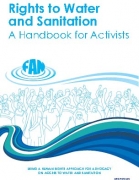Conservation - Reducing Water Usage
Water Expo 2011, 16th - 18th March, 2011, Nandambakkam, Chennai
Posted on 28 Feb, 2011 01:25 PM Organizer: Water Today
Organizer: Water Today
Venue: Chennai Trade Center, Nandambakkam, Chennai
Topics:
- Latest Technologies in Water Conservation, Harvesting Technologies & Water Audit
- Advances in Industrial Wastewater Treatment (Oil, Greaves Removal, Electroplating Removal, Insecticides and Pesticides)
Map your events on World Water Day 2011
Posted on 24 Feb, 2011 03:03 PM
This year's theme, Water for cities: Responding to the urban challenge, aims to spotlight and encourage governments, organizations, communities, and individuals to actively engage in addressing the defy of urban water management.
Water and culture vis-à-vis river diversions - Paper presented at the National Seminar on Water and Culture (2007)
Posted on 14 Feb, 2011 04:48 AMThis paper discusses river linking, as a part of an ancient tradition, and suggests how NGOs can play a role in this attempt. The example of the Koyna dam is taken, and the effective handling of the technical and human angle of the dams construction is detailed through in-depth study and detailed field visits.
Water conservation in the dry regions of India for sustainable agriculture - Paper presented at the National Seminar on Water and Culture (2007)
Posted on 14 Feb, 2011 04:31 AMThis paper attempts to discuss farm water conservation techniques and multiple cropping patterns with the idea of minimising water use. The authors provide a glimpse of agricultural facts that include total geographical area, net sown area etc. They provide population trends in the country to point out to the water and food stress.
Watershed prioritisation atlas for Maharashtra
Posted on 09 Feb, 2011 07:34 AMThis document by the Maharashtra Remote Sensing Applications Centre (MRSAC) presents the “Atlas on Watershed Prioritisation” using resources database on 1:2,50,000 scale adopting a
An insight on legal aspect of groundwater use by industries and water tax/rate/fee by Emami Paper Mills Limited
Posted on 07 Feb, 2011 06:03 PM- Meaning of Ground Water
- Water located beneath the ground surface.
Groundwater is stored in and moves slowly through layers of soil, sand and rocks called aquifers. Aquifers typically consist of gravel, sand, sandstone, or fractured rock, like limestone.
Conjunctive use of surface water and ground water - Lecture delivered by Dr. R. Jagadiswara Rao at National Water Academy, Pune
Posted on 03 Feb, 2011 12:09 PM
Dr. R. Jagadishwara Rao
Former Professor of Geology
Sri Venkateswara University
Tirupati, AP 517502
"Recommendations on water and sanitation services to urban poor"
Posted on 02 Feb, 2011 05:31 PMThe India WASH Forum newsletter for January 2011. It is an open platform for engagement on contemporary issues, for an independent credible voice in the water, sanitation and hygiene sector.
- Recommendations on water and sanitation services to urban poor
The group came up with a list of prioritised issues that need immediate attention if the urban poor were to be provided with sustainable and equitable water and sanitation services. - Water resources are under stress of depletion as well as denial of access for the poor
Drinking water needs are met primarily from ground water. Except for the large metros that suck away water from rivers, most small towns in India depend on ground water supply.
Right to water and sanitation - A handbook for activists by Freshwater Action Network (FAN) Global
Posted on 31 Jan, 2011 10:11 PM With tihs, they can improve water and sanitation service regulation and provision at international, national and local levels. Directed primarily at community groups, human rights NGOs, rights-based development practitioners and aid workers, this handbook aims to strengthen human rights-based advocacy by providing innovative and practical suggestions that activists and organisations can use in their work. It also acts as a resource guide for finding further information.
With tihs, they can improve water and sanitation service regulation and provision at international, national and local levels. Directed primarily at community groups, human rights NGOs, rights-based development practitioners and aid workers, this handbook aims to strengthen human rights-based advocacy by providing innovative and practical suggestions that activists and organisations can use in their work. It also acts as a resource guide for finding further information.
Water and sanitation are essential for living a healthy life with dignity. However, around a billion people across the world lack access to a safe and sufficient water supply to cover their basic needs. Over 2.5 billion people lack access to adequate sanitation and nearly 1.2 billion face the indignity of open defecation every day.
The Millennium Development Goal (MDG) target to halve the proportion of people without sustainable access to safe drinking water and basic sanitation by 2015 is seriously off track, with sanitation severely lagging behind. For example, estimates suggest that at current rates of progress, sub-Saharan Africa will miss the MDG water target by about 25 years, while the sanitation target may not be reached until well into the 22nd century.





